Whether you're a new or experienced remote employee, you've probably realized how hard it can be to stay on a proper schedule.
In the morning, you might wake up drowsy with no commute or morning team chats to put you in the work mindset. Then, when you finally feel like you're on a roll and about to get everything on your to-do list done, you might look out the window, realize how dark it is, and discover that you've worked straight through dinner.
At HubSpot, where we have a fleet of over 300 full-time remote employees, we hear about the above scenario a lot. And, we've also seen that remote workers across companies share the same struggles.
Although the schedule mishap I noted above is fairly common, you definitely don't want it to become a regular part of your lifestyle. While working late at night occasionally can help you get ahead in your career, doing so regularly can harm your mental health, happiness at work, and your work-life balance.
When it comes to remote work, the stakes of poor scheduling impacting you might be even higher. Research shows that remote employees tend to work longer hours than in-office employees. Remote work can also result in feelings of disconnection, isolation, and loneliness.
If you've fallen for numerous scheduling traps as a remote marketer, it doesn't mean you're a bad employee or going downhill in your career. A scheduling mishap simply means that you might need some daily structure, like many other people with ambiguous working styles.
Luckily, with all of the scheduling technology we have today, creating an outline of your workweek actually isn't that hard to do.
In this blog post, I'll walk you through how to create an effective weekly schedule that allows you to stay on task, manage multiple projects, and take time to maintain your work-life balance.
If you're interested in building your own Google Calendar and want to steal some of these tips, click here to add this calendar template to your own GSuite account.
<iframe src="https://calendar.google.com/calendar/embed?src=hubspot.com_tllbrlnk778ms443j0d0re85ck%40group.calendar.google.com&ctz=America%2FNew_York" style="border: 0" width="800" height="600" frameborder="0" scrolling="no"></iframe>
What to Schedule on Your Weekly Remote Work Calendar
1. Block your non-working hours.
One of the biggest challenges that remote employees face is the inability to tune out and unplug after a long day of work. Without social cues to leave the office at the end of the day, many remote employees report working longer hours and having less time for social interaction outside of their home because they get too focused on work.
As a hardworking remote marketer, you might feel like you have to be "always online." However, many of HubSpot's own remote marketers actually advise others who work from home to set boundaries for their schedule early on.
"It’s easy to fall into the trap of getting things done during the day, but still feeling like you’ve wasted your time and now need to work later in the evening," says Rebecca White, a junior staff writer for the HubSpot Blog. "Setting boundaries for yourself and having a routine schedule will help avoid those pitfalls.”
After you discuss your working hours and work-life balance boundaries with your manager, you should note them on your calendar so your team is able to know when you're available and when you're logged off.
One handy way to note working and non-working times is by using Google Calendar's Working Hours setting to visibly mark the times you won't be on the clock. This allows teammates to see when your preferred work hours are and blocks them from scheduling meetings during off-work times.
To do this on Google Calendar, simply go to your calendar, click Settings, and scroll down to Working Hours on the Settings dashboard.

Once you update your working hours, other calendar viewers will see gray lines during the times and days which you're unavailable for meetings. If you don't use Google Calendar, a few other scheduling programs, such as the Microsoft Outlook calendar similarly allow you to mark these times.
2. Schedule time to do regular weekly duties.
Every job has a few weekly duties that you'll take on regularly. To isolate these regular duties so that they don't impact bigger projects, consider scheduling a time to do them each day.
For example, in this screenshot, I've scheduled the time I've devoted to producing and scheduling marketing emails for the HubSpot Blog. This helps me get the emails done early on so I can focus more of my day on creative projects, strategizing, or other heads-down tasks. It also allows me to add some structure to my day, especially when working remotely.
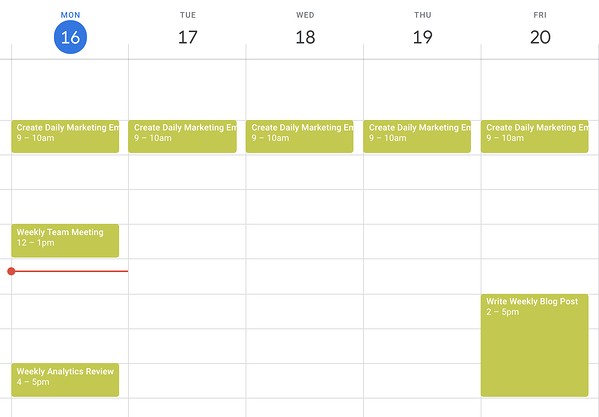
3. Create blocks that say, "Please Request Time Before Booking" for times when you'll be doing larger projects.
Sometimes, you'll need to have an hour or more of uninterrupted time to ensure that you get a project done thoroughly. When meetings interrupt these times, they can throw you off your train of thought or hinder your creativity.
As a blogger who's also managing audience growth strategies, I have a mix of regular small tasks and larger, more intense tasks to accomplish each week. When I'm working in the office, next to my teammates, it's easy to talk through my schedule and prioritize. But, when I'm working from home, the temptation to check emails and respond to Slack messages can distract me from my heads-down work.
Because of this, I schedule time to do my core, unchanging tasks, as well as time I'll need to zone in on creative projects, such as content strategies or blog posts. This helps me keep a centered routine and get work done, while also allowing me to pivot to unexpected tasks as needed.
In the example below, I created a time block for blog-writing, which many marketers multitask with a wide range of other duties.
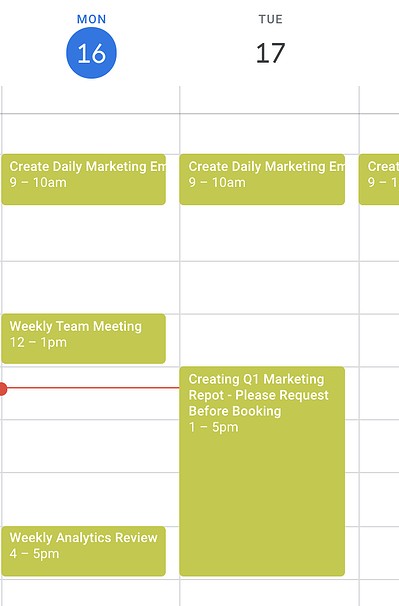
4. Schedule regular check-ins with colleagues you don't see often.
Two other common challenges remote employees deal with are disconnected from teammates and lack of company visibility. To help avoid these barriers, many remote members of our marketing team schedule regular one-on-one check-ins or virtual coffee chats with other colleagues.
"I schedule monthly one-on-ones with colleagues I work closely with but don’t always cross paths with in meetings," says Meg Prater, the remote Managing Editor of the HubSpot Blog. "I also grab virtual coffees and lunches with colleagues — and book my calendar with lots of face-to-face catch-ups when I’m in the office."
As a remote employee, regular meetings help you get to know your team, stay up to date with what's going on in the office, and gain valuable visibility that you might not get in larger virtual teammeetings.
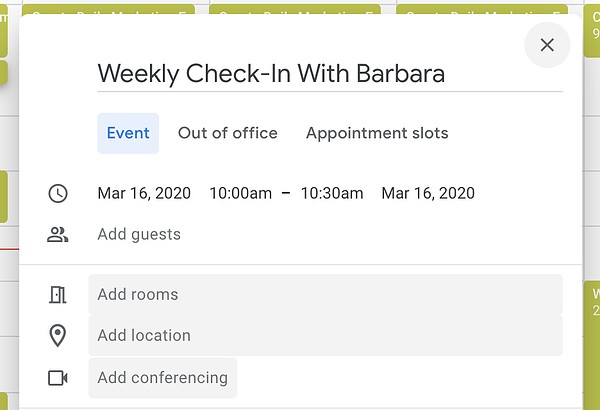
5. Include your morning routine.
One thing I and my remote colleagues have found is that we feel more productive in our remote work when we have a morning routine. And, this makes sense.
Think about it. When you work in the office, you might wake up in the morning, get dressed, wake yourself up with coffee, and then amp yourself up for your day by listening to music or a podcast on your morning commute. When you work remotely, in your own home, there are less outside factors that can help pep you up for the day ahead.
While you might be tempted to sleep in until your team is online, we'd actually suggest that you give yourself time for a morning routine. Morning routines not only allow you to start your day off on the right foot, but they also offer you time to use self-care, bond with your family, or take care of any errands or chores that could be a distraction later in the day.
Regardless of which morning routine you follow, it can be helpful to time block this in your calendar to remind you to make a bit of time for yourself and your personal life before you get started with your workday.
6. Make time for breaks each day.
Aside from making time for self-care in the mornings, you should also remember to take breaks once you dive into your workday.
Why mark breaks on your calendar if you already work from home? While you might hear people say, "Remote workers have plenty of time for self-care," this statement is actually one of the biggest and most inaccurate myths we've heard.
This is a myth that Prater noted for a recent blog post:
"I always thought I’d turn into a super-athletic woman when I became remote. I thought I’d go to yoga every day during lunch, take up running as a mid-morning break. It turns out, I sometimes forget to take a break long enough to refill my coffee cup -- let alone run to a yoga class mid-day," Prater revealed.
Taking breaks can be challenging when you feel like you're churning out great content or are wirjubg on a deadline. But, many of our marketers say they can help prevent burnout and boost creativity.
If you think you need to take more breaks, but find it hard to remember to, create a 15 to 30 minute time slot for an afternoon break on your calendar each day. You don't always have to use that time for a break, but getting the calendar reminder will remind you to take some time for yourself at some point.
7. Block time for other work-life-balance needs.
As a career-minded professional, you might be worried that taking time for your family or yourself can leave the impression that you're not taking work seriously. In fact, this is the opposite.
The workplace is actually becoming more and more accepting of flexible work. According to LinkedIn, 72% of recruiters say flexible schedules will shape future workplaces and hiring success.
If your manager allows you to work flexibly or pause work during the day for a personal life commitment or errand, such as picking up a child from school, you should note these occurrences on your calendar. This will allow your team to know when you're busy and cannot be booked for a meeting while also giving you uninterrupted time to maintain work-life balance.
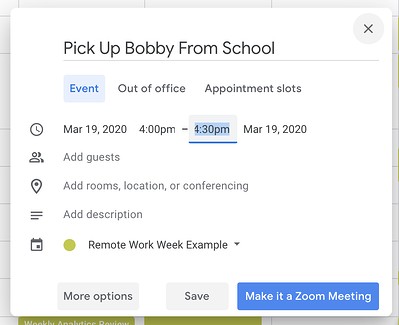
8. Consider booking as many meetings as possible within one to two days each week.
One of the best pieces of advice that I've gotten from my remote colleagues is to book all of my meetings in a cluster early in the week, which leaves more time open for heads down projects or activities at the end of the week.
This is a strategy often used by one of the blog's remote content strategists, Allie Decker.
“If you can, group all your meetings so they happen over the course of two or three days. Leave a couple of days wide open to get that heads-down, max-effort work done," said Decker in a recent blog post.
Decker added that you can also use this time "to get out of the house, change up your workspace, and not have to worry about taking video or phone calls in loud public spots.”
To help you visualize how to schedule your meetings in blocks, here's an example. Below, I've scheduled my check-ins on the same day as my weekly team meeting. Then, by Wednesday, you can see that my schedule is opening up and becoming more flexible for more intensive tasks.
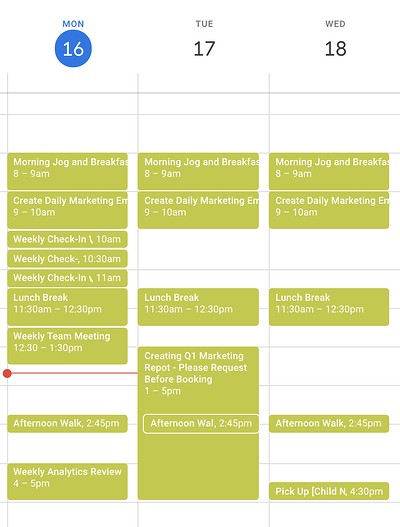
9. Leave some openings in time each day.
If you're a very organized person, it can be hard to avoid scheduling every second of your day, but for the sake of teamwork, you'll want to leave some unscheduled space on your calendar.
Why? When you're working remotely, you might want to have a virtual call with a teammate at the last minute because it's simply easier to discuss something in-person or through text-based communication.
This strategy can be especially helpful if you're a team manager who wants to remain accessible to all employees.
"Be ready to jump on a video-call without having to schedule time for it," says Susanne Ronnqvist Ahmadi, HubSpot's Vice President of International Marketing. "Let your teams know you're available over your instant messaging tool and build in “air-time” in your agenda for check ins and quick chats.
Communicating Your Schedule
Remember, a great schedule means nothing if you don't communicate about your boundaries and work hours with your team. To make sure you maintain your weekly routine, be sure to discuss the schedule you settle on with your manager and notify your colleagues of times that you have set as unavailable. This solid communication will help to ensure that your working hours are both respected and effective.
For more tips about how to be a successful remote employee, check out this blog post with tips from members of our own remote workforce. You might also like these posts related to remote work stats, common myths, and tips for gaining visibility from home.
